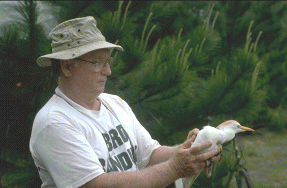| PWRC Home | | | BBL Home | | | Contact Us | | | Canadian Wildlife Service |

Bird banding data are useful in both research and management projects. Individual identification of birds makes possible studies of dispersal and migration, behavior and social structure, life-span and survival rate, reproductive success and population growth.

Click here to view a larger version of this map
Every bander participates in studies of dispersal and migration by sending all their banding data in to a central site like the Bird Banding Laboratory. When banded birds are captured, released alive and reported from somewhere else we can reconstruct the movements of the individual bird.
In this way we have learned that some species go south in one pathway and return north by another pathway. Nesting and wintering grounds have been located for some species, and specific nesting grounds have been connected to specific wintering areas. The Arctic Tern makes the longest migration flight of any living species, making an annual round trip flight of 25,000 miles. The migration routes used by this species have been determined by band recoveries in part.
The Bird Banding Laboratory can give banders permission to use radio transmitters to track individual birds. The radios may be on a standard research frequency for tracking local movements or the dispersal of young birds from the area where they were raised. Some researchers are using satellite transmitters on birds which allow the researcher to track the bird anywhere on the earth. A wealth of information can be learned from using satellite radios, but they are expensive and although technology is allowing them to be made lighter and lighter, the bird must still be a relatively large species to be able to carry a satellite transmitter at this time.
Many researchers use banding as one tool in their studies of bird populations and communities. The Bird Banding Laboratory can give banders permission to use additional techniques to study birds, including markers that are more visible than the metal service bands. Some banders use colored leg bands to mark individual birds and study their local movements and behaviors from a distance. Individual identification of birds allows many things to be studied without handling the bird again. Some things that may be studied include territorial behavior, mate fidelity, territory size and fidelity, reproductive behavior (which bird builds the nest? Feeds the young? How often?).
Banding allows the determination of the minimum length of time that an individual bird lives. Without an individual marker, there would be no way to determine if the Cardinal that is outside my window is the same bird that I saw last year or not. With a bird band, if I catch that Cardinal today and band it, I will know if that one bird is caught again in the future.
We have learned, for example, that it is not uncommon for individuals of some species to live 10 to 20 years or more in the wild. Small songbirds that we may think of as short-lived may live a surprising length of time. We have a record of a hummingbird living as long as 12 years! However, the average life span of the majority of the individuals is much shorter.
Longevity Records by Species Number
Banding and marking birds can also be used to estimate the numbers of birds in a population using a mark-recapture technique. Birds are marked in one time period, and then recaptured or resighted in a later time period. The number of birds marked in the first period and the ratio of marked to unmarked birds in the population in the second period allow the total population of birds to be estimated.
Banding data allows for the comparison of normal, wild banded birds with birds that may have had their survival altered by exposure to oil or other hazards. Survival and Productivity can be studied by using a constant effort banding site. The Monitoring Avian Productiviy and Survivorship(MAPS) program is a cooperative research effort of the Institute for Bird Populations and banders throughout North America.
Birds can be vectors of diseases which effect people, including encephalitis and Lyme disease. Sampling wild birds for serious disease helps determine the prevalence of the disease in the population. Banding allows for birds that have been sampled once to be avoided in the next sample--or to be resampled, depending on the study.
Toxicology projects using banding assess the turnover time or how long birds use an area once they arrive in it. This allows the researcher to determine the potential exposure of birds to chemicals in contaminated areas.
An analysis of banding information from game birds is completed annually and is essential for hunting regulations development and for detecting changes in waterfowl populations. Banding data can be used to assess the hunting pressure, estimate productivity and survival, and measure the vulnerability of the age/sex classes to hunting pressure.
More about the uses of bird banding data